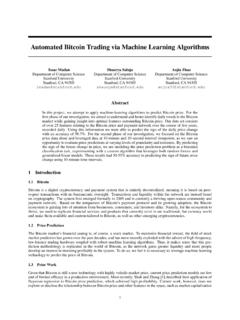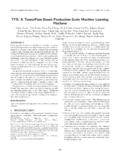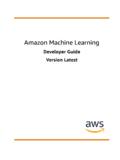Transcription of Machine Learning Powers Autonomous Industrial Systems
1 Machine Learning Powers Autonomous Industrial Systems Matthieu Chevrier, Systems & applications managerWorldwide Industrial systemsTexas InstrumentsTobias Puetz, Systems engineerWorldwide Industrial Systems Texas InstrumentsSemiconductor advancements make factories smarter, safer and more efficient 2 Machine Learning Powers Autonomous Industrial Systems October 2017 Running a factory that perfects itself would seem to be the ideal dream of a manufacturing operations manager. What could be better than having automated Systems that learn from their mistakes and continually improve? Imagine quality soaring to new levels, and just-in-time production becoming invariable. Productivity, reliability and efficiency would reach previously unattainable heights, leading to higher profits and growth. Remarkably, the operations manager s dream is about to come true, at least to some extent. Machines that learn to improve their own performance are becoming the basis of advanced manufacturing, thanks to innovative semiconductor technology and internet-based artificial intelligence (AI).
2 Today Industrial sensors are raising the available information to the next level by communicating a mushrooming volume of data to the internet cloud, where it is collected to be analyzed using AI techniques. Based on the findings, instructions can be fed back to automated tools such as robots and process control Systems to steadily improve their factory-wide Machine Learning depends on massive data storage and computation within the cloud. It also requires distributed intelligence and wired and wireless communications in numerous sensors and automated Systems on the factory floor and in on-site control centers. If cloud-based AI and factory control centers are the brains of the operation, then sensors are the eyes and ears, and robots and other automated Systems are the arms and legs. With feedback from the eyes and ears, and clever insight from the brains, the arms and legs can be trained to perform complex operations more precisely and respond appropriately to varying conditions.
3 The results are higher quality, greater productivity, improved energy efficiency, and greater safety for the human workers who train, maintain and collaborate with the machines in the production Learning is an important component of contemporary factory automation based on a web of distributed sensing, communications and control intelligence. Today s progress in manufacturing is so marked that it has been dubbed Industry (following the previous big advances of steam power , the assembly line and early automation). Innovation in a number of fields, not least of these the underlying semiconductor technology developed by Texas Instruments (TI), provides the momentum for Industry and its successes in productivity, efficiency, precision, flexibility and cloud-based AI and factory control centers are the brains of the operation, then sensors are the eyes and ears, and robots and other automated Systems are the arms and legs. 3 Machine Learning Powers Autonomous Industrial Systems October 2017 The importance of Machine Learning in manufacturing Traditionally, the complex tools used in manufacturing have been built to perform repetitive tasks, with some variation in response due to feedback from designed-in sensing and control intelligence.
4 Reprogramming the system s parameters permits greater variation so that, for example, a robot can perform a different set of movements, or a chemical process control system can create a different type of batch. The Machine is tested and calibrated using metrics sampled from the , the tool works as intended all the time and the process never fails. But manufacturing conditions are seldom ideal. Materials vary from lot to lot, ambient conditions such as temperature change, and dust and grime accumulate. Within the Machine itself, components heat up and moving parts wear down. As a result, outputs begin to vary more, with ripple effects on later stages in production. Inevitably come rejected units, scrapped materials, production down time, straighten it out maintenance, wasted time and energy, and lost , new developments in automated Systems now make it possible for machines to learn from changing conditions, minimize these challenges, and reduce waste. The first step involves the collection of massive amounts of data.
5 An explosive growth in the number of connected sensors provides vast quantities of data to the cloud concerning temperature, pressure, proximity, orientation, distances, chemical composition, and many other factors that influence manufacturing processes. Video cameras often complement sensors by recognizing patterns and perceiving movement. Used jointly, sensors and video can provide a highly accurate report on production processes in a complex, changing environment, in a manner comparable to their developing use on the streets by self-driving vast amounts of information provided to remote data centers serve as the raw materials of data mining, neural networks and other techniques employed in AI to improve operation of automated Systems . Whereas setting parameters for tools has typically relied on sampling from scores or hundreds of measurements, future machines will benefit from the analysis of billions. Robots will compensate more precisely for drift as they heat up and their bearings wear.
6 Chemical control Systems will optimize recipes as they adjust to subtle differences in supply batches. Motors working in tandem will function more efficiently as their loads change. All Systems will respond more exactly to changes in ambient conditions and will monitor the environment and themselves more effectively for predictive maintenance and 1. A self-controlled Machine acts based on wisdom distilled from lower levels ultimately arising from massive amounts of data. KnowledgeInformationDataApplied:Combined with other information, time to start moving robot arm nowWisdomContent:Part will be heated perfectly in 10sMeaning:Temperature in oven has reached 600 CRaw:Type K voltage: 24 mV 4 Machine Learning Powers Autonomous Industrial Systems October 2017A practical example for the use of AI on a factory floor is the continuous enhancement in visual pattern recognition. Deep Learning algorithms using neural networks have demonstrated their power in recognizing highly variable patterns such as handwriting.
7 Such techniques will surely be used, along with other recognition algorithms, to enhance the utility of video addition to continually improving precision at levels that are unachievable today, AI techniques are expected to define parameters based on patterns that are still too difficult to detect. For instance, in a case when process experts are baffled why seemingly identical operations on one assembly line have lower yields than on another line, data mining may pinpoint the answer in an unexpected possibilities for analyzing data and using it to improve the operation of Industrial automated Systems are limited only by the imagination of tool designers and AI experts. Many advances will depend on problem-solving collaboration between AI and human specialists who provide guidance and minimize start-up errors. With Machine Learning still in its infancy, some techniques are yet to be invented. As increasingly complex mechanical, chemical and biological manufacturing processes come online, such procedures will be indispensable for continual requirements of Systems that learn Advanced Industrial automation, including Machine Learning , is due to widespread sensing, distributed Machine intelligence, and extensive wired and wireless communications.
8 Though the different Systems involved have some functions in common, design requirements vary extensively among them, and design engineers must rely on advanced integrated circuit (IC) technology to meet these important area of IC innovation is in sensing. Sensors are usually small, including a sensing element, signal amplification, analog-to-digital conversion (ADC), and communication. A microcontroller (MCU) may be included, especially if the sensor is integrated with other functions. Sensors are often placed in hard-to-access locations, where the circuitry must be highly integrated, communicate wirelessly, and operate with ultra-low- power consumption that permits years of operation without battery contrast with sensors, video cameras produce a massive amount of pixel data that requires extensive processing by a heterogeneous mix of microprocessors, digital signal processors (DSPs) and hardware accelerators. Video communication is normally wired because of the high data stream, though camera Systems employ compression and techniques such as object recognition for limiting IntelligenceSuperset of ML where behavior reaches for certain tasks human-like performancesMachine LearningSuperset of DL where statistical methods are used to improve over timeDeep LearningSuperset of functional programming where deep neural networks are used to compute desired outputsFunctional ProgrammingSpecific output defined by current state and inputsFigure 2.
9 AI includes a wide area of research and application, some of which is devoted to how machines such as automated manufacturing Systems can improve their performance and learn new tasks on their own. 5 Machine Learning Powers Autonomous Industrial Systems October 2017 Robots and other automated Systems are normally self-contained units with local control that handles routine operation and safety overrides. Communication with remote intelligence permits reprogramming and coordination with the rest of the plant. Although the traditional Industrial robot operated within a safety barrier, robots are increasingly being designed to collaborate with workers in factories and warehouses. In these cases, integrated intelligence directs the robot what it should do when it senses a human presence. Programs, and the underlying processors, are becoming increasingly complex as automated Systems respond to more internal and external sensors and their behaviors become more adaptable.
10 The addition of Machine Learning amplifies this communications vary considerably, requiring support from the simpler interfaces such as IO-Link all the way to Industrial real-time Ethernet. On the wireless front, mesh Bluetooth is gaining traction very fast, but proprietary solutions and older standards such as WiFi and WHART are also increasing their penetrations on factory floors. A frequent challenge remains to provide greater bandwidth, deterministic behavior, low power and robust protocol covering extremely varied configurations that can range from kilometer-wide plants to compact, noisy factory floors. Network security is also crucial, and semiconductor solutions must support encryption and other security measures to prevent the corruption of data streams and instructions by outside equipment must also be designed with safety in mind, using reinforced isolation technology to prevent system damage and injury to people from voltage spikes and transients. Signal isolation helps to preserve the integrity of internal signals and prevent unwanted feedback onto external lines.

















![A arXiv:1409.0473v7 [cs.CL] 19 May 2016](/cache/preview/2/1/9/2/c/e/b/f/thumb-2192cebf55d1f97cb647eb48fdb384b3.jpg)